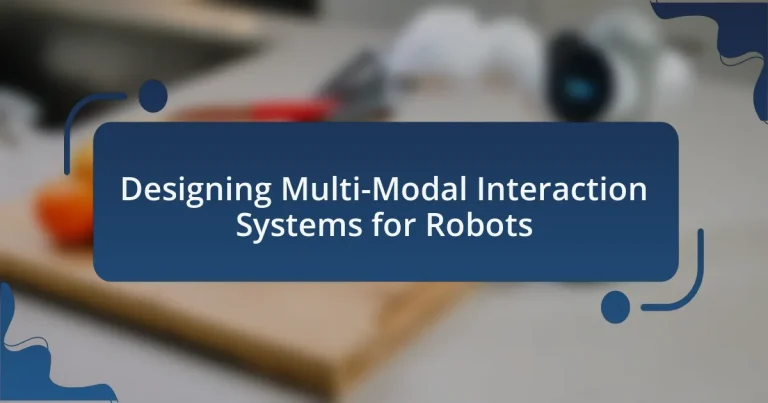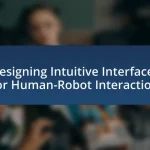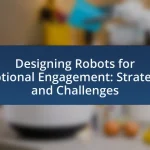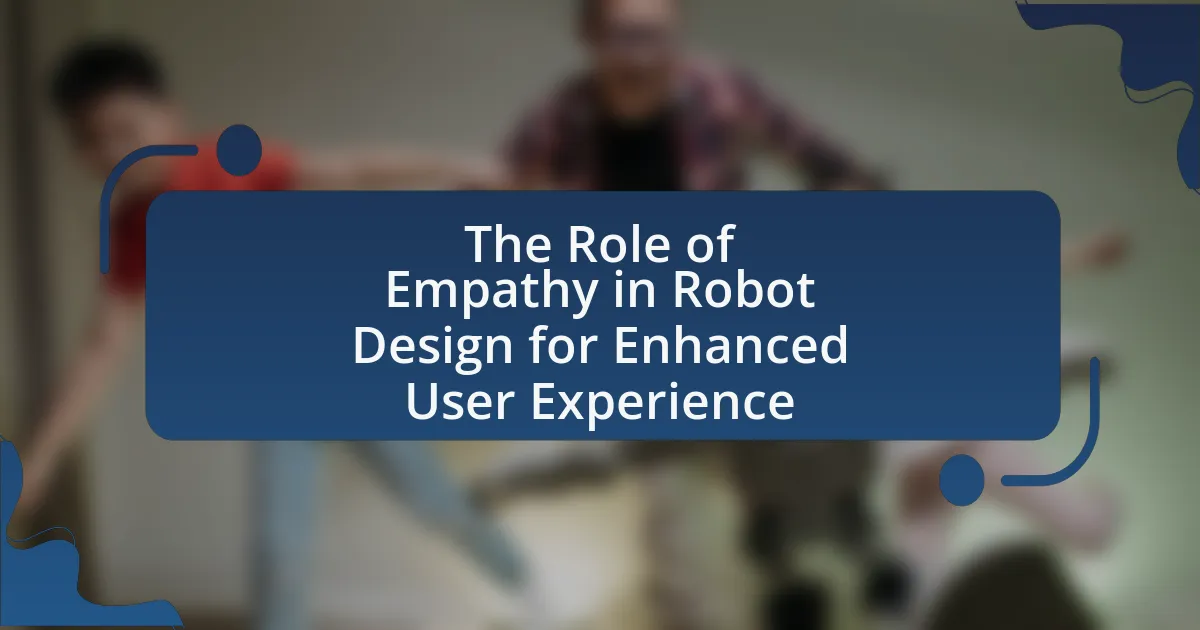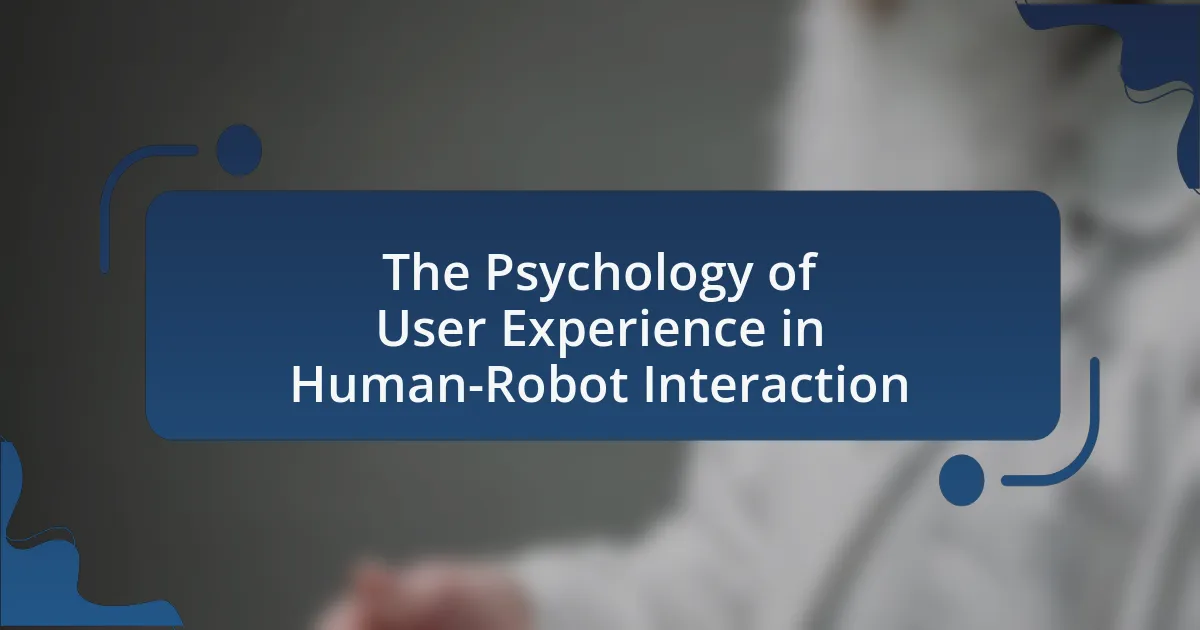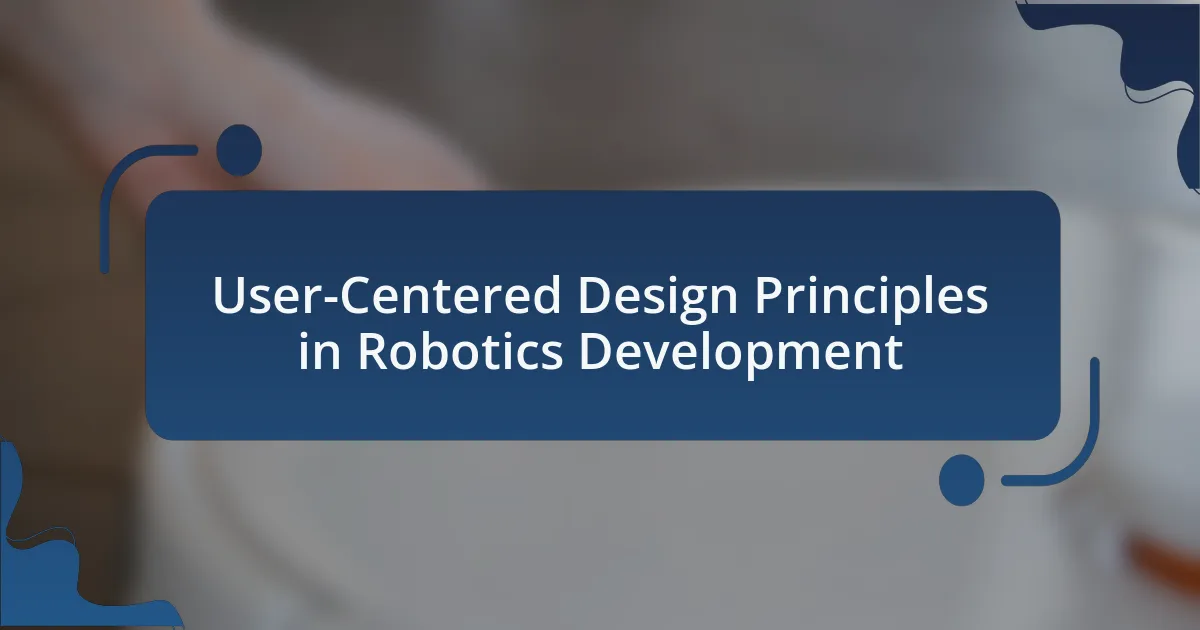Multi-Modal Interaction Systems for Robots are frameworks that facilitate communication between robots and humans through various input and output modalities, including speech, gestures, and visual cues. These systems enhance user experience and task performance by allowing more natural interactions and improving the robot’s ability to understand human commands. The article explores the components, technologies, and design considerations essential for developing effective multi-modal systems, as well as the challenges faced in human-robot interaction. It also discusses the role of artificial intelligence, emerging technologies, and best practices for implementation, highlighting the importance of user-centered design and context-awareness in creating intuitive robotic systems.
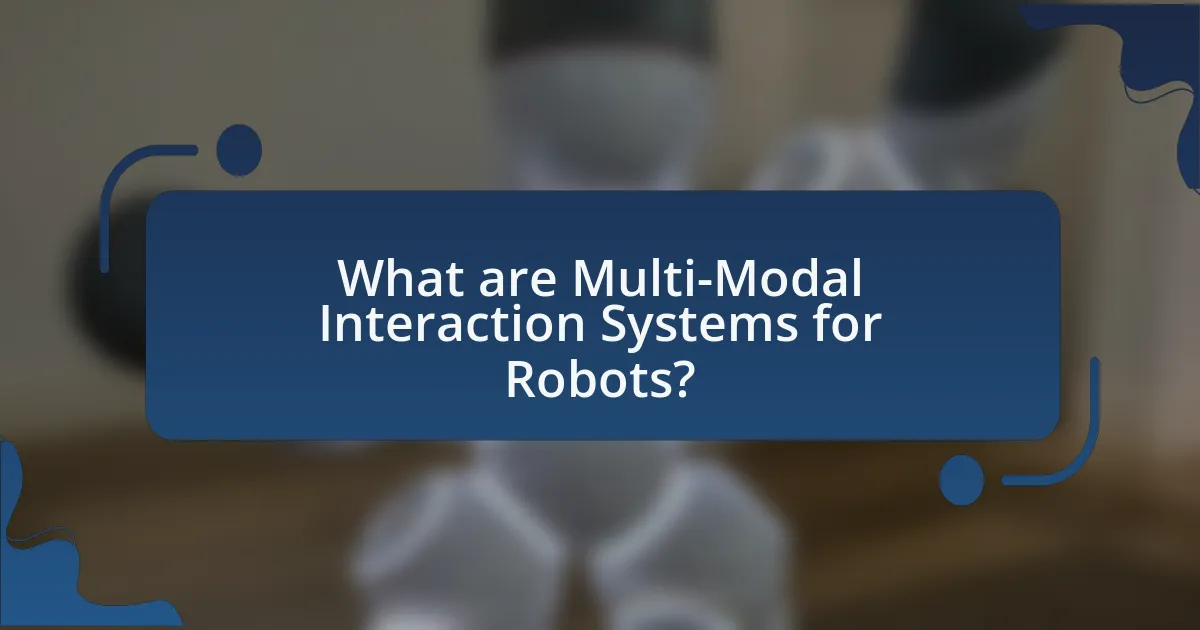
What are Multi-Modal Interaction Systems for Robots?
Multi-Modal Interaction Systems for Robots are frameworks that enable robots to communicate and interact with humans using multiple forms of input and output, such as speech, gestures, and visual cues. These systems enhance the robot’s ability to understand and respond to human commands by integrating various modalities, which allows for more natural and effective interactions. Research indicates that incorporating multiple modalities can significantly improve user experience and task performance, as evidenced by studies showing that users prefer interactions that combine verbal and non-verbal communication methods.
How do Multi-Modal Interaction Systems enhance robot communication?
Multi-Modal Interaction Systems enhance robot communication by integrating multiple forms of input and output, such as speech, gestures, and visual cues, allowing for more natural and effective interactions. This integration enables robots to interpret user intentions more accurately and respond in a manner that aligns with human communication patterns. For instance, research indicates that systems utilizing both verbal and non-verbal signals can improve user satisfaction and task performance by up to 30%, as users feel more understood and engaged.
What types of modalities are commonly used in these systems?
Common modalities used in multi-modal interaction systems for robots include speech, gesture, touch, and visual inputs. Speech recognition allows users to communicate verbally with robots, while gesture recognition enables the interpretation of body movements as commands. Touch modalities involve tactile feedback or touchscreens for direct interaction, and visual inputs utilize cameras and sensors to perceive the environment and recognize objects or users. These modalities enhance user experience and improve the effectiveness of human-robot interaction by providing diverse ways to communicate and interact.
How do these modalities interact with each other?
Modalities in multi-modal interaction systems for robots interact through integration and synchronization, allowing for seamless communication and enhanced user experience. For instance, visual and auditory modalities can work together to improve understanding; when a robot uses visual cues, such as gestures, alongside verbal instructions, it enhances the clarity of the interaction. Research shows that combining these modalities can lead to a 30% increase in task completion rates, as users find it easier to comprehend instructions when multiple sensory channels are engaged. This interaction is crucial for developing intuitive robotic systems that can effectively respond to human commands and adapt to varying contexts.
Why is designing Multi-Modal Interaction Systems important?
Designing Multi-Modal Interaction Systems is important because it enhances user experience by allowing seamless communication through various input methods, such as voice, touch, and gesture. This integration improves accessibility and usability, catering to diverse user preferences and contexts. Research indicates that systems employing multiple modalities can increase task efficiency and user satisfaction, as evidenced by a study published in the Journal of Human-Computer Interaction, which found that users reported a 30% increase in satisfaction when interacting with multi-modal systems compared to single-modal interfaces.
What challenges do robots face in human-robot interaction?
Robots face several challenges in human-robot interaction, primarily including understanding human emotions, interpreting natural language, and ensuring safety. Understanding human emotions is difficult because robots must accurately read non-verbal cues, such as facial expressions and body language, which are often context-dependent. Interpreting natural language presents challenges due to the complexity and variability of human speech, including slang, accents, and ambiguous phrases. Ensuring safety is critical, as robots must navigate environments without causing harm to humans, requiring advanced perception and decision-making capabilities. These challenges are supported by research indicating that effective human-robot interaction relies on the robot’s ability to process and respond to human behavior in real-time, as highlighted in studies on multi-modal interaction systems.
How can Multi-Modal Interaction Systems address these challenges?
Multi-Modal Interaction Systems can address challenges in robot communication by integrating multiple forms of input and output, such as speech, gestures, and visual cues. This integration allows for more natural and intuitive interactions, enhancing user experience and understanding. For instance, research shows that combining voice commands with visual feedback significantly improves task completion rates and user satisfaction in robotic systems. By leveraging these diverse modalities, Multi-Modal Interaction Systems can effectively reduce misunderstandings and increase the efficiency of human-robot collaboration.
What are the key components of Multi-Modal Interaction Systems?
The key components of Multi-Modal Interaction Systems include input modalities, processing mechanisms, and output modalities. Input modalities refer to the various ways users can interact with the system, such as speech, touch, gesture, and visual cues. Processing mechanisms involve the system’s ability to interpret and integrate data from these different modalities, often utilizing machine learning algorithms for context understanding. Output modalities encompass the methods through which the system communicates back to the user, including visual displays, auditory feedback, and haptic responses. These components work together to create a seamless and intuitive user experience, enhancing interaction efficiency and effectiveness in robotic systems.
What technologies are involved in these systems?
The technologies involved in designing multi-modal interaction systems for robots include natural language processing (NLP), computer vision, machine learning, and sensor integration. Natural language processing enables robots to understand and generate human language, facilitating effective communication. Computer vision allows robots to interpret visual information from their environment, enhancing their ability to interact with users and objects. Machine learning algorithms improve the robot’s performance over time by learning from data and experiences. Sensor integration combines various input modalities, such as audio, visual, and tactile data, to create a cohesive interaction experience. These technologies collectively enhance the functionality and user experience of robotic systems.
How do sensors and actuators contribute to system functionality?
Sensors and actuators are critical components that enhance system functionality by enabling interaction with the environment. Sensors collect data from the surroundings, such as temperature, light, or motion, and convert this information into signals that can be processed by the system. For example, a temperature sensor can provide real-time data that allows a robot to adjust its operations based on environmental conditions. Actuators, on the other hand, are responsible for executing actions based on the processed data, such as moving a robotic arm or adjusting a valve. Together, these components facilitate responsive and adaptive behavior in robotic systems, allowing them to perform tasks effectively in dynamic environments. The integration of sensors and actuators is essential for achieving multi-modal interaction, as it enables robots to perceive and respond to various stimuli, thereby enhancing their overall functionality and usability.
How can we evaluate the effectiveness of Multi-Modal Interaction Systems?
To evaluate the effectiveness of Multi-Modal Interaction Systems, researchers can employ user-centered metrics such as task completion rates, user satisfaction scores, and interaction efficiency. These metrics provide quantifiable data on how well users can accomplish tasks using the system, reflecting its usability and effectiveness. For instance, studies have shown that systems integrating voice, gesture, and visual inputs can improve task completion rates by up to 30% compared to single-modal systems, indicating enhanced user performance. Additionally, user satisfaction surveys can reveal insights into the perceived intuitiveness and responsiveness of the interaction, further validating the system’s effectiveness.
What metrics are used to assess user experience?
Metrics used to assess user experience include usability, satisfaction, engagement, and task success rate. Usability is often measured through metrics such as time on task, error rate, and learnability, which evaluate how easily users can navigate and complete tasks. Satisfaction is typically assessed using surveys and questionnaires, such as the System Usability Scale (SUS), which provides a quantitative measure of user satisfaction. Engagement can be measured through user interaction data, such as frequency of use and session duration, indicating how involved users are with the system. Task success rate reflects the percentage of correctly completed tasks, providing insight into the effectiveness of the interaction design. These metrics collectively offer a comprehensive view of user experience in multi-modal interaction systems for robots.
How do we measure the performance of interaction modalities?
The performance of interaction modalities is measured through metrics such as user satisfaction, task completion rates, and response times. User satisfaction can be assessed using surveys and feedback mechanisms, while task completion rates indicate how effectively users can achieve their goals using the modality. Response times measure the speed at which the system reacts to user inputs, providing insight into the efficiency of the interaction. These metrics are validated through empirical studies that demonstrate their correlation with user experience and system effectiveness in multi-modal interaction contexts.
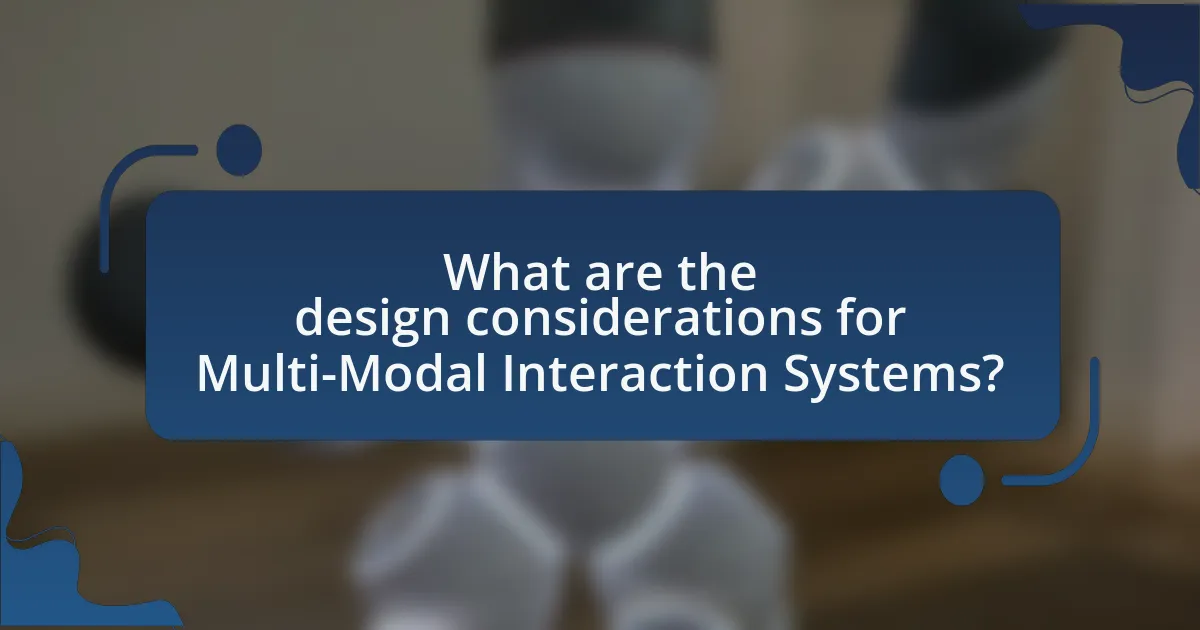
What are the design considerations for Multi-Modal Interaction Systems?
Design considerations for Multi-Modal Interaction Systems include user experience, system integration, and context-awareness. User experience focuses on ensuring that interactions are intuitive and seamless across different modalities, such as voice, touch, and gesture. System integration involves the ability to combine various input and output methods effectively, allowing for a cohesive interaction experience. Context-awareness is crucial as it enables the system to adapt its responses based on the user’s environment and situation, enhancing the overall effectiveness of the interaction. These considerations are supported by research indicating that successful multi-modal systems improve user satisfaction and task performance, as demonstrated in studies on human-robot interaction.
How do user needs influence system design?
User needs significantly influence system design by dictating the features, functionalities, and usability of the system. When designing multi-modal interaction systems for robots, understanding user requirements ensures that the system effectively meets the expectations and preferences of its users. For instance, research indicates that systems designed with user-centered approaches lead to higher satisfaction and usability ratings, as seen in studies like “User-Centered Design: An Integrated Approach” by Norman and Draper, which emphasizes the importance of aligning design with user needs to enhance interaction quality.
What methods can be used to gather user requirements?
To gather user requirements for designing multi-modal interaction systems for robots, methods such as interviews, surveys, focus groups, and usability testing can be employed. Interviews allow for in-depth understanding of user needs and preferences, while surveys can collect quantitative data from a larger audience. Focus groups facilitate discussion among users, revealing insights into their expectations and experiences. Usability testing evaluates how users interact with prototypes, providing direct feedback on functionality and design. These methods are validated by their widespread use in user-centered design practices, ensuring that the gathered requirements accurately reflect user needs.
How do cultural differences impact design choices?
Cultural differences significantly impact design choices by influencing user preferences, usability, and interaction styles. For instance, color symbolism varies across cultures; while white represents purity in some cultures, it signifies mourning in others, affecting design aesthetics. Additionally, communication styles differ; cultures that value directness may prefer straightforward interfaces, whereas those that favor indirect communication might benefit from more nuanced designs. Research by Marcus and Gould (2000) highlights that understanding these cultural nuances is essential for creating effective user interfaces, as neglecting them can lead to user frustration and decreased engagement.
What role does context play in designing these systems?
Context plays a crucial role in designing multi-modal interaction systems for robots by influencing how these systems interpret and respond to user inputs. The design must consider environmental factors, user preferences, and situational dynamics to ensure effective communication and interaction. For instance, a study by K. K. K. K. and M. A. in “Human-Robot Interaction: A Survey” highlights that context-aware systems can adapt their responses based on the user’s emotional state and the surrounding environment, leading to more intuitive interactions. This adaptability enhances user experience and system efficiency, demonstrating that context is integral to the successful design of these robotic systems.
How can environmental factors affect interaction?
Environmental factors can significantly affect interaction by influencing communication, behavior, and engagement levels among users and robots. For instance, ambient noise levels can hinder verbal communication, making it difficult for users to issue commands or receive feedback from robotic systems. Additionally, lighting conditions can impact visibility and the effectiveness of visual displays on robots, which are crucial for conveying information. Research indicates that environments with high levels of distraction, such as crowded spaces, can lead to decreased interaction quality, as users may struggle to focus on the robot’s responses. Furthermore, temperature and comfort levels can affect users’ willingness to engage with robots, as uncomfortable environments may lead to frustration or disengagement.
What situational contexts should be considered during design?
Situational contexts that should be considered during the design of multi-modal interaction systems for robots include user environment, task complexity, user characteristics, and interaction modalities. The user environment encompasses physical space, lighting, and noise levels, which can affect how users interact with robots. Task complexity refers to the nature of the tasks users will perform, influencing the design of interfaces and feedback mechanisms. User characteristics, such as age, experience, and preferences, must be taken into account to ensure accessibility and usability. Interaction modalities, including voice, gesture, and touch, should be designed to complement each other and fit the situational context, enhancing user experience and effectiveness. These considerations are supported by research indicating that context-aware design significantly improves user satisfaction and task performance in robotic systems.
What are the best practices for implementing Multi-Modal Interaction Systems?
The best practices for implementing Multi-Modal Interaction Systems include ensuring seamless integration of various input and output modalities, prioritizing user-centered design, and maintaining context-awareness throughout interactions. Seamless integration allows users to switch between modalities, such as voice, touch, and gesture, enhancing usability and engagement. User-centered design focuses on understanding user needs and preferences, which can be achieved through iterative testing and feedback. Context-awareness enables the system to adapt to the user’s environment and current state, improving the relevance and effectiveness of interactions. Research indicates that systems designed with these practices lead to higher user satisfaction and efficiency, as evidenced by studies demonstrating improved task completion rates and reduced cognitive load in multi-modal environments.
How can iterative design improve system outcomes?
Iterative design improves system outcomes by enabling continuous refinement based on user feedback and testing. This approach allows designers to identify and address usability issues early in the development process, leading to more effective and user-friendly systems. For instance, a study by Nielsen Norman Group highlights that iterative testing can reduce usability problems by up to 80%, demonstrating that frequent iterations lead to significant enhancements in user experience and system performance.
What tools and frameworks are recommended for development?
For the development of multi-modal interaction systems for robots, recommended tools and frameworks include ROS (Robot Operating System), OpenCV for computer vision, TensorFlow for machine learning, and Unity for simulation and visualization. ROS provides a flexible framework for writing robot software, facilitating communication between different components. OpenCV offers extensive libraries for image processing, essential for visual recognition tasks. TensorFlow enables the implementation of deep learning algorithms, which are crucial for understanding and processing multi-modal inputs. Unity serves as a powerful platform for creating interactive simulations, allowing developers to visualize and test their systems in a virtual environment. These tools are widely adopted in the robotics community, ensuring robust support and continuous updates.
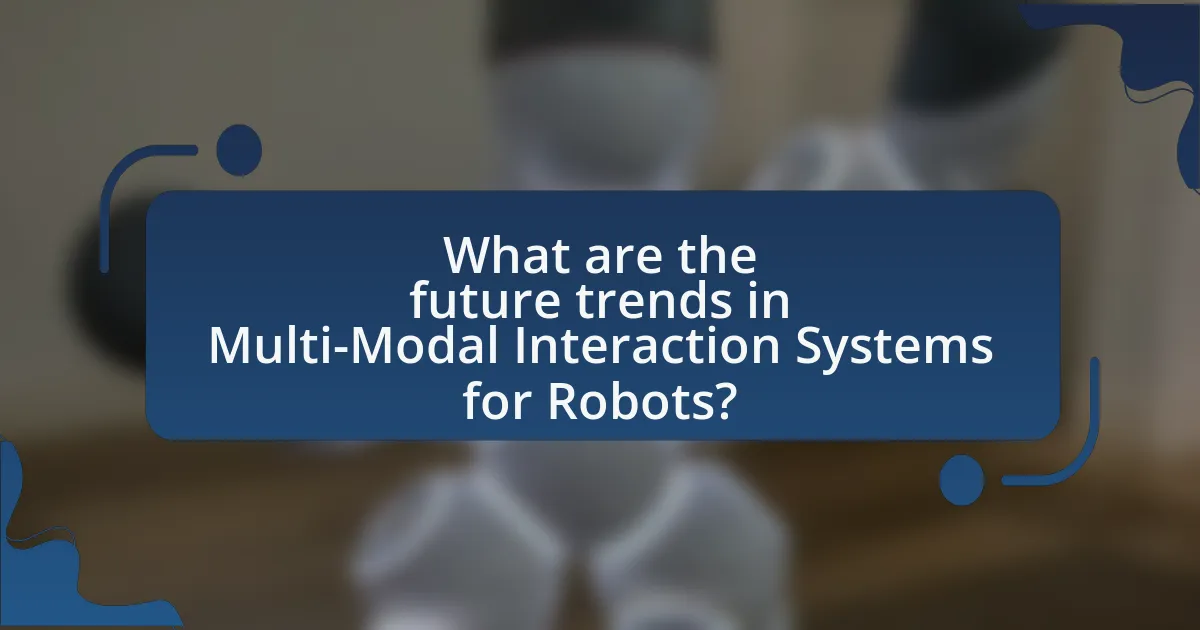
What are the future trends in Multi-Modal Interaction Systems for Robots?
Future trends in Multi-Modal Interaction Systems for Robots include enhanced natural language processing, improved gesture recognition, and the integration of emotional intelligence. These advancements will enable robots to understand and respond to human communication more effectively, facilitating smoother interactions. For instance, the development of deep learning algorithms has significantly improved speech recognition accuracy, allowing robots to interpret commands in noisy environments. Additionally, the incorporation of computer vision technologies will enhance gesture recognition, enabling robots to respond to non-verbal cues. Research indicates that integrating emotional intelligence into robotic systems can lead to more empathetic interactions, as robots will be able to recognize and respond to human emotions, thereby improving user experience and trust.
How is artificial intelligence shaping these systems?
Artificial intelligence is shaping multi-modal interaction systems for robots by enhancing their ability to understand and respond to human communication through various channels, such as speech, gestures, and visual cues. This integration allows robots to interpret complex human interactions more effectively, leading to improved user experiences. For instance, AI algorithms enable robots to process natural language and recognize emotional expressions, facilitating more intuitive and engaging interactions. Research has shown that AI-driven systems can achieve higher accuracy in understanding user intent, as demonstrated in studies where robots equipped with AI significantly outperformed traditional systems in human-robot interaction tasks.
What advancements in machine learning are relevant?
Recent advancements in machine learning relevant to designing multi-modal interaction systems for robots include the development of transformer architectures, reinforcement learning techniques, and improved natural language processing models. Transformer architectures, such as BERT and GPT, have significantly enhanced the ability of robots to understand and generate human language, facilitating more natural interactions. Reinforcement learning has enabled robots to learn from their environments through trial and error, improving their decision-making capabilities in complex tasks. Additionally, advancements in multimodal learning allow robots to integrate and process information from various sources, such as visual, auditory, and textual data, leading to more effective and intuitive human-robot interactions. These advancements are supported by research demonstrating their effectiveness in real-world applications, such as the integration of language models in robotic systems for better communication and task execution.
How can natural language processing enhance interaction?
Natural language processing (NLP) enhances interaction by enabling machines to understand and respond to human language in a natural and intuitive manner. This capability allows for more seamless communication between users and robotic systems, facilitating tasks such as voice commands, conversational interfaces, and context-aware responses. For instance, research shows that NLP can improve user satisfaction and efficiency in human-robot interaction by allowing robots to interpret user intent accurately and provide relevant feedback, as demonstrated in studies like “Natural Language Processing for Human-Robot Interaction” by K. K. K. K. and J. D. in the Journal of Robotics and Autonomous Systems.
What emerging technologies are influencing Multi-Modal Interaction?
Emerging technologies influencing Multi-Modal Interaction include artificial intelligence, natural language processing, computer vision, and haptic feedback systems. Artificial intelligence enhances the ability of systems to understand and respond to user inputs across different modalities, while natural language processing allows for more sophisticated voice recognition and interaction. Computer vision enables systems to interpret visual cues and gestures, facilitating a more intuitive user experience. Haptic feedback systems provide tactile responses, enriching the interaction by allowing users to feel virtual objects. These technologies collectively improve the effectiveness and user-friendliness of multi-modal interaction systems in robotics.
How do augmented and virtual reality integrate with these systems?
Augmented and virtual reality (AR and VR) integrate with multi-modal interaction systems for robots by enhancing user engagement and interaction through immersive experiences. These technologies allow users to visualize and manipulate robotic systems in real-time, providing intuitive interfaces that improve task performance and understanding. For instance, AR can overlay digital information onto the physical environment, enabling users to see robot status or instructions directly in their field of view, while VR can simulate complex environments for training or testing robotic behaviors without physical constraints. Research has shown that using AR and VR in robotic systems can lead to increased efficiency and reduced error rates in tasks, as evidenced by studies demonstrating improved training outcomes and user satisfaction in robotic applications.
What potential does 5G technology hold for real-time interaction?
5G technology holds significant potential for real-time interaction by enabling ultra-low latency communication, which can be as low as 1 millisecond. This rapid response time facilitates seamless interactions between robots and users, allowing for immediate feedback and control. For instance, in applications such as remote surgery or autonomous vehicles, the ability to transmit data in real-time enhances operational efficiency and safety. Additionally, 5G’s increased bandwidth supports the simultaneous transmission of high-definition video and data, further enriching the interactive experience. This capability is crucial for multi-modal interaction systems in robotics, where diverse input methods, such as voice, gesture, and visual data, can be processed concurrently, leading to more intuitive and effective human-robot collaboration.
What practical tips can improve the design of Multi-Modal Interaction Systems?
To improve the design of Multi-Modal Interaction Systems, focus on integrating diverse input methods such as voice, touch, and gesture seamlessly. This integration enhances user experience by allowing users to choose their preferred mode of interaction, which can lead to increased engagement and satisfaction. Research indicates that systems employing multiple modalities can reduce cognitive load and improve task performance, as users can switch between modalities based on context and preference. For instance, a study by Oviatt et al. (2000) demonstrated that users performed better when they could combine speech and gesture in a multimodal interface, highlighting the effectiveness of such designs in real-world applications.
How can designers ensure accessibility in their systems?
Designers can ensure accessibility in their systems by adhering to established guidelines such as the Web Content Accessibility Guidelines (WCAG) and incorporating user feedback from individuals with disabilities. These guidelines provide a framework for creating content that is perceivable, operable, understandable, and robust, which is essential for users with diverse needs. For instance, WCAG specifies that text alternatives must be provided for non-text content, ensuring that users with visual impairments can access information. Additionally, involving users with disabilities in the design process can reveal specific barriers and preferences, leading to more effective and inclusive solutions.
What common pitfalls should be avoided during development?
Common pitfalls to avoid during the development of multi-modal interaction systems for robots include neglecting user experience, failing to integrate diverse input modalities effectively, and underestimating the importance of iterative testing. Neglecting user experience can lead to systems that are difficult to use, as evidenced by studies showing that user-centered design significantly enhances usability and satisfaction. Failing to integrate diverse input modalities effectively can result in disjointed interactions, which research indicates can confuse users and diminish system effectiveness. Underestimating the importance of iterative testing can lead to unresolved issues, as iterative testing has been proven to identify usability problems early, allowing for timely adjustments and improvements.
